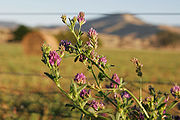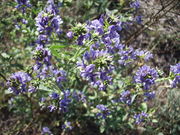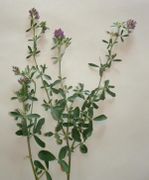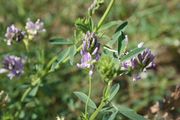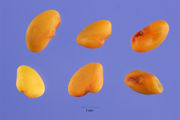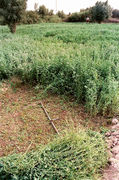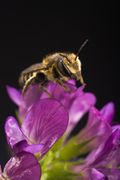Alfalfa
| Alfalfa | |
|---|---|
 |
|
| Medicago sativa | |
| Scientific classification | |
| Kingdom: | Plantae |
| Division: | Magnoliophyta |
| Class: | Magnoliopsida |
| Order: | Fabales |
| Family: | Fabaceae |
| Subfamily: | Faboideae |
| Tribe: | Trifolieae |
| Genus: | Medicago |
| Species: | M. sativa |
| Binomial name | |
| Medicago sativa L.[1] |
|
| Subspecies | |
|
Medicago sativa subsp. ambigua (Trautv.) Tutin |
|
Alfalfa (Medicago sativa L.) is a flowering plant in the pea family Fabaceae cultivated as an important forage crop. In the UK, Australia, South Africa and New Zealand it is known as lucerne and as lucerne grass in south Asia. It resembles clover with clusters of small purple flowers.
Contents |
Ecology
Alfalfa is a cool season perennial legume which can live more than twenty years, depending on variety and climate.[2] The plant grows to a height of up to 1 metre (3 ft), and has a deep root system sometimes stretching more than 15 metres (49 ft).[2] This makes it very resilient, especially to droughts.[2] It has a tetraploid genome.[3]
This plant exhibits autotoxicity, which means that it is difficult for alfalfa seed to grow in existing stands of alfalfa.[4] Therefore, it is recommended that alfalfa fields be rotated with other species (for example, corn or wheat) before reseeding.[5]
Culture
Alfalfa is widely grown throughout the world as forage for cattle, and is most often harvested as hay, but can also be made into silage, grazed, or fed as greenchop.[6] Alfalfa has the highest feeding value of all common hay crops, being used less frequently as pasture.[5] When grown on soils where it is well-adapted, alfalfa is the highest yielding forage plant.[7]
Its primary use is as feed for dairy cattle—because of its high protein content and highly digestible fiber—and secondarily for beef cattle, horses, sheep, and goats.[8][9] Humans also eat alfalfa sprouts in salads and sandwiches.[10][11] Dehydrated alfalfa leaf is commercially available as a dietary supplement in several forms, such as tablets, powders and tea.[12] Alfalfa is believed by some to be a galactagogue, a substance that induces lactation.[13]
Like other legumes its root nodules contain bacteria, Sinorhizobium meliloti, with the ability to fix nitrogen, producing a high-protein feed regardless of available nitrogen in the soil.[14] Its nitrogen-fixing abilities (which increases soil nitrogen) and its use as an animal feed greatly improved agricultural efficiency.[15][16]
Alfalfa can be sown in spring or fall, and does best on well-drained soils with a neutral pH of 6.8 – 7.5.[17][18] Alfalfa requires sustained levels of potassium and phosphorus to grow well.[19] It is moderately sensitive to salt levels in both the soil and in irrigation water, although it continues to be grown in the arid southwestern United States where salinity is an emerging issue.[20][21][22] Soils low in fertility should be fertilized with manure or a chemical fertilizer, but correction of pH is particularly important.[23] Usually a seeding rate of 13 – 20 kg/hectare (12 – 25 lb/acre) is recommended, with differences based upon region, soil type, and seeding method.[24] A nurse crop is sometimes used, particularly for spring plantings, to reduce weed problems and soil erosion but can lead to competition for light, water and nutrients.[25]
In most climates alfalfa is cut three to four times a year but is harvested up to 12 times per year in Arizona and southern California.[26][27] Total yields are typically around 8 tonnes per hectare (4 short tons per acre) but yields have been recorded up to 20 t/ha (16 short tons per acre).[27] Yields vary with region, weather, and the crop's stage of maturity when cut. Later cuttings improve yield but reduce nutritional content.[28]
Alfalfa is considered an insectary due to the large number of insects it attracts.[29] Some pests such as Alfalfa weevil, aphids, armyworms, and the potato leafhopper can reduce alfalfa yields dramatically, particularly with the second cutting when weather is warmest.[30] Chemical controls are sometimes used to prevent this.[30] Alfalfa is also susceptible to root rots including Phytophthora, Rhizoctonia, and Texas Root Rot.[31][32][33]
Harvesting

When alfalfa is to be used as hay, it is usually cut and baled.[34] Loose haystacks are still used in some areas, but bales are easier for use in transportation, storage and feed.[35] Ideally, the first cutting should be taken at the bud stage and the subsequent cuttings just as the field is beginning to flower, or one tenth bloom for the reason that carbohydrates are at their highest.[36] When using farm equipment rather than hand-harvesting, a swather cuts the alfalfa and arranges it in windrows.[37] In areas where the alfalfa does not immediately dry out on its own, a machine known as a mower-conditioner is used to cut the hay.[34] The mower-conditioner has a set of rollers or flails that crimp and break the stems as they pass through the mower, making the alfalfa dry faster.[38] After the alfalfa has dried, a tractor pulling a baler collects the hay into bales.
There are several types of bales commonly used for alfalfa. For small animals and individual horses, the alfalfa is baled into small two string bales commonly named by the strands of string used to wrap the bale smallest two string, three string, and so on up to half ton bales six string "square" bales — actually rectangular, and typically about 40 x 45 x 100 cm (14 in x 18 in x 38 in).[3] Small square bales weigh from 25 – 30 kg (50 – 70 pounds) depending on moisture, and can be easily hand separated into "flakes". Cattle ranches use large round bales, typically 1.4 to 1.8 m (4 to 6 feet) in diameter and weighing from 500 to 1,000 kg, (1000 to 2000 lbs). These bales can be placed in stable stacks or in large feeders for herds of horses, or unrolled on the ground for large herds of cattle.[3] The bales can be loaded and stacked with a tractor using a spike, known as a bale spear, that pierces the center of the bale.[39] Or they can be handled with a grapple (claw) on the tractor's front-end loader. A more recent innovation is large "square" bales, roughly the same proportions as the small squares, but much larger. The bale size was set so that stacks would fit perfectly on a large flatbed truck. These are more common in the western United States.
When used as feed for dairy cattle alfalfa is often made into haylage by a process known as ensiling.[40] Rather than drying it to make dry hay, the alfalfa is chopped finely and fermented in silos, trenches, or bags, anywhere where the oxygen supply can be limited to promote fermentation.[41] The anaerobic fermentation of alfalfa allows it to retain high nutrient levels similar to those of fresh forage, and is also more palatable to dairy cattle than dry hay.[42] In many cases, alfalfa silage is inoculated with different strains of microorganisms to improve the fermentation quality and aerobic stability of the silage.[43]
Worldwide production
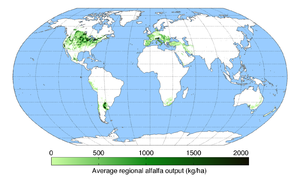
Alfalfa is the most cultivated legume in the world. Worldwide production was around 436 million tons in 2006.[44]. The US is the largest alfalfa producer in the world, but considerable area is found in Argentina (primarily grazed), Australia, South Africa, and the Middle East.
Within the United States, the leading alfalfa growing states are California, South Dakota, and Wisconsin. The upper Midwestern states account for about 50% of US production, the Northeastern states 10%, the Western states 40%, and the Southeastern states almost none. Alfalfa has a wide range of adaptation and can be grown from very cold northern plains to high mountain valleys, from rich temperate agricultural regions to Mediterranean climates and searing hot deserts.
Alfalfa and bees
Alfalfa seed production requires the presence of pollinators when the fields of alfalfa are in bloom.[3] Alfalfa pollination is somewhat problematic, however, because Western honey bees, the most commonly used pollinator, are not suitable for this purpose; the pollen-carrying keel of the Alfalfa flower trips and strikes pollinating bees on the head, which helps transfer the pollen to the foraging bee.[3] Western honey bees, however, do not like being struck in the head repeatedly and learn to defeat this action by drawing nectar from the side of the flower. The bees thus collect the nectar but carry no pollen and so do not pollinate the next flower they visit.[45] Because older, experienced bees don't pollinate alfalfa well, most pollination is accomplished by young bees that have not yet learned the trick of robbing the flower without tripping the head-knocking keel. When western honey bees are used to pollinate alfalfa, the beekeeper stocks the field at a very high rate to maximize the number of young bees.[45]
Today the alfalfa leafcutter bee is increasingly used to circumvent this problem.[46] As a solitary but gregarious bee species, it does not build colonies or store honey, but is a very efficient pollinator of alfalfa flowers.[46] Nesting is in individual tunnels in wooden or plastic material, supplied by the alfalfa seed growers.[45] The leafcutter bees are used in the Pacific Northwest, while western honeybees dominate in California alfalfa seed production.[45]
A smaller amount of alfalfa produced for seed is pollinated by the alkali bee, mostly in the northwestern United States. It is cultured in special beds near the fields. These bees also have their own problems. They are not portable like honey bees; and when fields are planted in new areas, the bees take several seasons to build up.[45] Honey bees are still trucked to many of the fields at bloom time.
Varieties
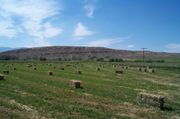
Considerable research and development has been done with this important plant. Older cultivars such as 'Vernal' have been the standard for years, but many better public and private varieties are now available and better adapted to particular climates.[47] Private companies release many new varieties each year in the US.[48]
Most varieties go dormant in the fall, with reduced growth in response to low temperatures and shorter days.[48] 'Non-dormant' varieties that grow through the winter are planted in long-seasoned environments such as Mexico, Arizona, and Southern California, whereas 'dormant' varieties are planted in the Upper Midwest, Canada, and the Northeast.[48] 'Non-dormant' varieties can be higher yielding, but they are susceptible to winter-kill in cold climates and have poorer persistence.[48]
Most alfalfa cultivars contain genetic material from Sickle Medick (M. falcata), a wild variety of alfalfa that naturally hybridizes with M. sativa to produce Sand Lucerne (M. sativa ssp. varia). This species may bear either the purple flowers of alfalfa or the yellow of sickle medick, and is so called for its ready growth in sandy soil.[49]
Most of the improvements in alfalfa over the last decades have consisted of better disease resistance on poorly drained soils in wet years, better ability to overwinter in cold climates, and the production of more leaves. Multileaf alfalfa varieties have more than three leaflets per leaf, giving them greater nutritional content by weight because there is more leafy matter for the same amount of stem.
The California Alfalfa Workgroup [1] (UC Davis) has an up to date listing of Alfalfa Variety Trial Data [2] by location as well as Agronomy Progress Reports for each year.
Genetically modified alfalfa
Roundup Ready alfalfa is a genetically modified variety, patented by Monsanto Company, that is resistant to Monsanto's glyphosate. Although most broadleaf plants, including ordinary alfalfa, are sensitive to Roundup, growers can spray fields of Roundup Ready alfalfa with Roundup, and so kill the weeds without harming the alfalfa crop.
Legal issues in the US
Roundup Ready alfalfa was sold in the United States from 2005-2007 and more than 300,000 acres (1,200 km2) were planted with it, out of 21,000,000 acres (85,000 km2). However, in 2006, organic farmers, concerned about the impact of GM alfalfa on their crops, sued Monsanto (Monsanto Company v. Geertson Seed Farms[50]).[51] In response, in May 2007, the California Northern District Court issued an injunction order prohibiting farmers from planting Roundup Ready alfalfa until the US Department of Agriculture (USDA) completed a study on the genetically engineered crop's likely environmental impact. As a result, the USDA put a hold on any further planting of Roundup Ready alfalfa. The key issues of the lawsuit were the possibility that Roundup Resistance could be transmitted to other plants, including both other crops and weeds, making major pest species resistant to an important herbicide, Roundup; also, a big concern was the contamination of organic alfalfa crops.[52] On 21 June, 2010, the US Supreme Court has issued a ruling on this matter. The impact of this ruling is somewhat unclear, with both sides appearing to claim victory.[53] According to Barry Estabrook, at 'The Atlantic' website,
Even though Monsanto technically won, the most important parts of the lower court's decision were upheld, meaning there are still many regulatory hurdles GM alfalfa has to clear before it can be legally planted on a commercial scale. And in a decision that may have wide-reaching effects on future GM cases, the justices agreed that GM crops could cause environmental harm through cross-pollination.[54]
Phytoestrogens in alfalfa
Alfalfa, like other leguminous crops, is a known source of phytoestrogens.[55] Grazing on alfalfa has been suspected as a cause of reduced fertility in sheep.
Medical Uses
Alfalfa has been used as an herbal medicine for over 1,500 years. Alfalfa is high in protein, calcium, plus other minerals, vitamins in the B group, vitamin C, vitamin E, and vitamin K.[56][57]
Traditional Uses
In early Chinese medicines, physicians used young alfalfa leaves to treat disorders related to the digestive tract and the kidneys . In Ayurvedic medicine, physicians used the leaves for treating poor digestion. They made a cooling poultice from the seeds for boils. At the time, alfalfa was also believed to be helpful towards people suffering from arthritis and water retention .
Gallery
|
References
- ↑ "Medicago sativa - ILDIS LegumeWeb". www.ildis.org. http://www.ildis.org/LegumeWeb?sciname=Medicago+sativa. Retrieved 2008-03-07.
- ↑ 2.0 2.1 2.2 http://www.britannica.com/EBchecked/topic/14595/alfalfa
- ↑ 3.0 3.1 3.2 3.3 3.4 http://ddr.nal.usda.gov/bitstream/10113/22014/1/IND23276500.pdf
- ↑ http://www.uwex.edu/ces/forage/wfc/proceedings2001/understanding_autotoxicity_in_alfalfa.htm
- ↑ 5.0 5.1 http://www.kansasruralcenter.org/publications/alfalfa.pdf
- ↑ http://www.caf.wvu.edu/~forage/library/forglvst/bulletins/salfalfa.pdf
- ↑ <http://www.uky.edu/Ag/AnimalSciences/pubs/id97.pdf
- ↑ http://www.uaex.edu/Other_Areas/publications/PDF/FSA-4000.pdf
- ↑ http://www.hayusa.net/alfalfa.html
- ↑ http://cookeatshare.com/ingredients/alfalfa-sprouts
- ↑ <http://alfalfa.ucdavis.edu/IrrigatedAlfalfa/pdfs/UCAlfalfa8305Industrial_free.pdf
- ↑ http://www.nlm.nih.gov/medlineplus/druginfo/natural/patient-alfalfa.html
- ↑ http://www.midwiferytoday.com/enews/enews0614.asp
- ↑ http://cmgm.stanford.edu/~mbarnett/genome.htm
- ↑ https://portal.sciencesocieties.org/Downloads/pdf/B40724.pdf
- ↑ http://alfalfa.ucdavis.edu/-files/pdf/alfalfaFactSheet.pdf
- ↑ http://cestanislaus.ucdavis.edu/files/299.htm
- ↑ http://forageresearch.tamu.edu/1985/CloverEstablishmentGrowth.pdf
- ↑ http://www.ces.purdue.edu/extmedia/AY/AY-331-W.pdf
- ↑ http://extension.missouri.edu/publications/DisplayPub.aspx?P=G4555
- ↑ http://water.usgs.gov/nawqa/studies/mrb/salinity_briefing_sheet.pdf
- ↑ http://ag.arizona.edu/pubs/crops/az1129.pdf
- ↑ http://www.extension.umn.edu/distribution/cropsystems/DC3814.html
- ↑ http://www.uwex.edu/CES/crops/AlfSeedingRate.htm
- ↑ http://msuextension.org/publications/AgandNaturalResources/MT200504AG.pdf
- ↑ http://www.uwex.edu/ces/crops/uwforage/AlfalfaCutHeight.htm
- ↑ 27.0 27.1 http://www.cfaitc.org/Commodity/pdf/Alfalfa.pdf
- ↑ http://www.alfalfa.org/pdf/Alfalfa%20for%20Horses%20(low%20res).pdf
- ↑ http://www.pfspbees.org/Exhibit%203%20to%20PFSP%20Comments%20on%20NRCS%20Conservation%20Practice%20Standards.pdf
- ↑ 30.0 30.1 http://ohioline.osu.edu/ent-fact/0031.html
- ↑ http://nu-distance.unl.edu/homer/disease/agron/alfalfa/AlfPhyt.html
- ↑ http://ohioline.osu.edu/ac-fact/0042.html
- ↑ http://pods.dasnr.okstate.edu/docushare/dsweb/Get/Document-2321/EPP-7621web.pdf
- ↑ 34.0 34.1 http://www.uaex.edu/Other_Areas/publications/PDF/FSA-2005.pdf
- ↑ http://extension.missouri.edu/publications/DisplayPub.aspx?P=G4570
- ↑ ftp://ftp-fc.sc.egov.usda.gov/ID/programs/technotes/tn8_alfalfaguide3.pdf
- ↑ http://ucce.ucdavis.edu/files/repositoryfiles/ca1505p2-64859.pdf
- ↑ http://www.britannica.com/EBchecked/topic/257652/hay-mower-conditioner
- ↑ http://www.washburncompany.com/
- ↑ http://www.uaex.edu/Other_Areas/publications/PDF/FSA-4000.pdf
- ↑ http://ucanr.org/alf_symp/1995/95-55.pdf
- ↑ http://cals-cf.calsnet.arizona.edu/animsci/ansci/swnmc/papers/2005/Hartnell_SWNMC%20Proceedings%202005.pdf
- ↑ http://www.extension.iastate.edu/Publications/PM417H.pdf
- ↑ FAO, 2006. FAOSTAT-Food and Agriculture Organization of the United Nations
- ↑ 45.0 45.1 45.2 45.3 45.4 Milius, Susan (January 6 2007). "Most Bees Live Alone: No hives, no honey, but maybe help for crops". Science News 171 (1): 11–3. doi:10.1002/scin.2007.5591710110.
- ↑ 46.0 46.1 http://www.pollination.com/publications/IPSpub01.cfm
- ↑ http://ohioline.osu.edu/agf-fact/0014.html
- ↑ 48.0 48.1 48.2 48.3 http://msuextension.org/publications/AgandNaturalResources/MT199303AG.pdf
- ↑ Joseph Elwyn Wing, Alfalfa Farming in the U.S. 79 (Sanders Publishing Co. 1912).
- ↑ Monsanto Company v. Geertson Seed Farms at ScotusWiki - Briefs and Documents, etc.
- ↑ Hollow victory for Monsanto in alfalfa court case New Scientist, 22 June 2010 (accessed 22 June 2010)
- ↑ http://www.aphis.usda.gov/biotechnology/alfalfa.shtml
- ↑ Supreme Court on Modified Foods: Who Won? The Atlantic, by Barry Estabrook. June 22, 2010 (accessed June 22, 2010)
- ↑ Supreme Court on Modified Foods: Who Won?, by Barry Estabrook, 'The Atlantic'. June 22, 2010 (accessed June 22, 2010)
- ↑ Phytoestrogen content and estrogenic effect of legume fodder. PMID 7892287
- ↑ [http://www.nutritionresearchcenter.org/healthnews/alfalfas-nutritional-value/ Nutrition Research Center, Alfalfa Nutritional Value.
- ↑ The Facts About Alfalfa, Melissa Kaplans' Herb Care
